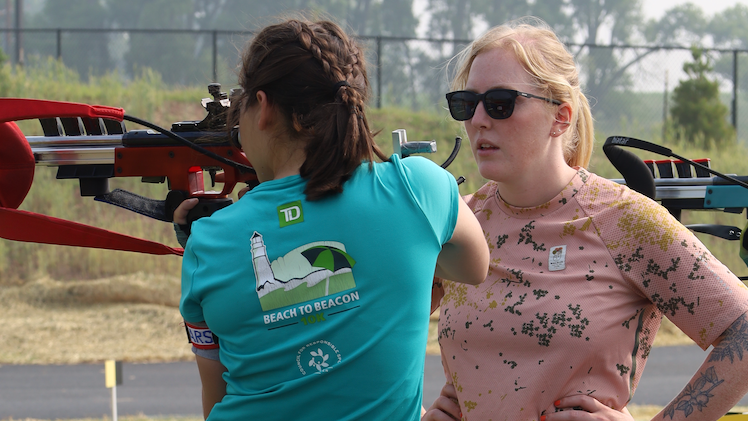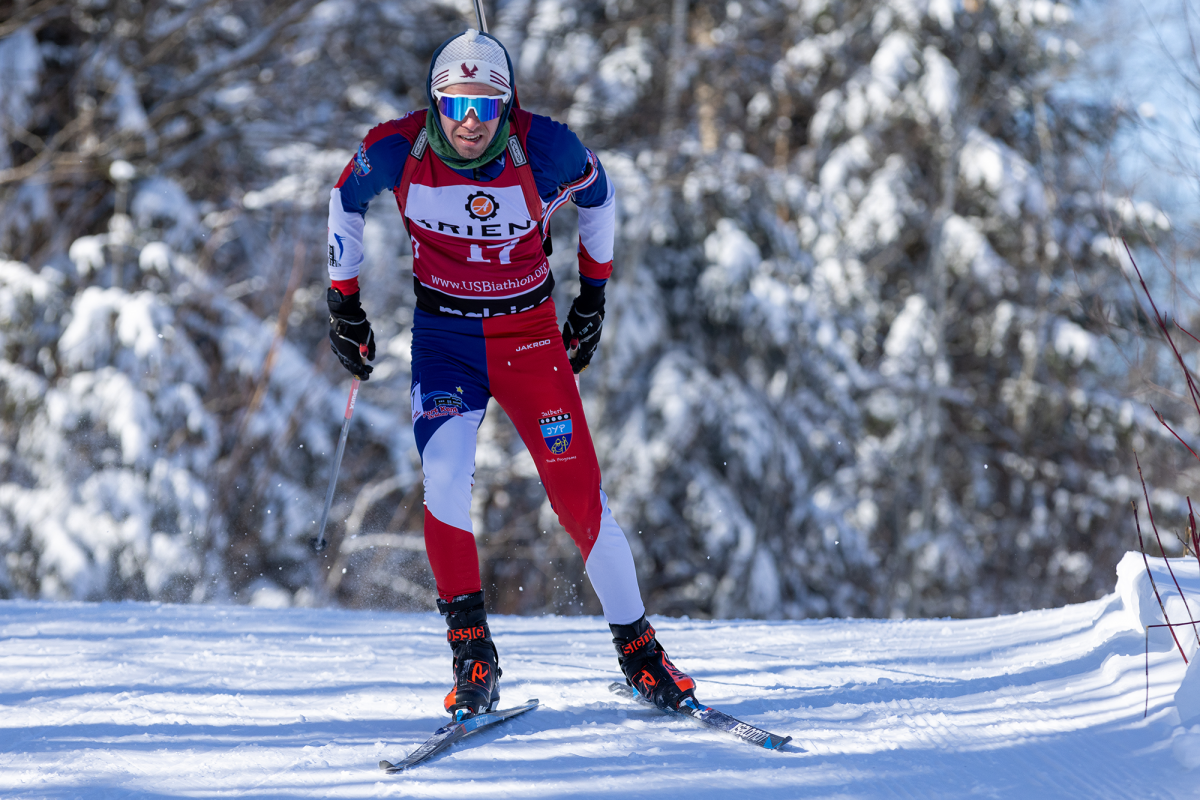
After a grueling early-winter schedule of three consecutive three-race weekends, biathletes around the world were ready to head home for the holidays.
But they had one last little piece of business to check off their lists before they departed from Hochfilzen, Austria on Sunday: the first mixed relay of the season. Athletes had to survive a quick six kilometers for the women, seven and a half for the men, and two shooting stages each.
A few teams and racers chose to cut out early. Norway, the defending World Champion in the event, did not field a team, and Germany, Sweden, and France benched some of their biggest stars.
“After three weeks of hard racing it’s kind of the last women and man standing,” United States Biathlon Association President and CEO Max Cobb said regarding team selection.
Partway through the second leg, it was clear that one team had managed to preserve the energies of its athletes best, and that was Russia.

After Olga Zaitseva took the lead on her last loop, the Russians never looked back. Between the Olga Vilukhina, who had tagged off in ninth, Zaitseva, Alexey Volkov, and Anton Shipulin, the team only missed five targets and thanks to the use of spare rounds never hit the penalty loop.
The two men not only hit every single target on their first try, but they had some of the fastest range times in the field. Shooting quickly and accurately, they quashed the hopes of the chase pack and waved goodbye to the possibility of getting caught. Shipulin stopped at the beginning of the stadium to grab a Russian flag and still finished with a lead of almost 30 seconds.
“The team was very strong and we were lucky- the shooting went very well,” said a modest Shipulin through a translator in the post-race press conference. “But I don’t think that we are the only team who can win the mixed relay. Today we won and maybe tomorrow another team will win.”
The victory gave Zaitseva three first-place finishes in as many races. In two weekends of racing in Hochfilzen, she has finished on the podium six times and now sits in fourth place in the overall World Cup rankings.
Behind Shipulin, the anchors for the French and Czech teams fought it out for second. While France started the last leg with a ten-second advantage, Simon Fourcade used one more spare round than Michal Slesingr, and by the last loop the two men were skiing together.
French fans may have wished that Fourcade’s younger brother Martin, who has already won two races this year, had anchored, because when Slesingr put in a charge up the course’s biggest hill, the elder Fourcade was unable to stay with him. As the pair jump-skated in unison at a speed that seemed impossible to maintain for the kilometer that remained before the finish, Fourcade was the one who fell off the pace.
“Already in the first loop I had tested Simon a little bit and realized I was skiing faster,” Slesingr said in a Czech Biathlon Union press release. “I believed, therefore, that the most difficult climb [was the crux].”
The Czech team wore black ribbons today to honor the death of Vaclav Havel, an activist and writer who helped bring the country out of communism and went on to serve as president for 14 years. Thanks to Slesingr’s skiing, they took second in comfortable fashion, 11 seconds ahead of France.
“I am pleased that everyone could see that [we] can compete,” said Czech women’s coach Henry Sikola. “I believe it will encourage our entire team… I think that such euphoria before the holidays is important and motivational.”
If that’s the case, then the Canadian team will have a very productive break. After Megan Imrie led off in tenth and Zina Kocher improved one spot, Brendan Green cleaned without using any spare rounds and skied his way into fourth place.
JP Le Guellec used two spare rounds in his standing stage, dropping the team to sixth place, but still notched one of the best results in national team history.

The athletes could not be reached for comment after the race.
Their northern neighbors may have finished higher, but the American team actually had a stronger start. Leadoff racer Sara Studebaker skied a smart leg and cleaned both prone and standing; she was in fourth place when she left the range the final time.
“Cleaning in a relay is always advantageous, and today it really worked out for me,” Studebaker wrote in an e-mail. “It was a pretty amazing feeling, leaving the range after standing in fourth!”
While she has had a few strong efforts so far this season, Studebaker is still working to consistently achieve the top-30 results she saw last season.
“This was a very solid day for me, and shows me that my ski speed and shooting are coming together,” she said. “It was the perfect race for me to head into the break on- it was the confidence boost I needed.”

Studebaker tagged off to Annelies Cook, who made the most of her first weekend of World Cup racing this season by cleaning prone and leaving the range in second.
“I finally did what I know I can do in the range and cleaned,” she told FasterSkier. “At this point, I’ll take whatever I can! I knew some of the big guns would catch me and so I just tried to keep doing my own thing so I wouldn’t come in too gassed.”
While Cook used two spare rounds to clean in standing, she still kept the team in a good position, tagging off in eighth with a group of other skiers.
“I was scared to let my teammates down and I am so happy I didn’t,” she wrote in an e-mail. “It’s a good way to go home for Christmas. Now I can finally relax.”

Tim Burke took over and had an inauspicious start, using all three available spare rounds in prone and dropping to twelfth. But after a single spare in standing, Burke turned in the fastest finishing loop of the leg and jetted back up to eighth, where he had started.
Leif Nordgren also needed four spare rounds, and the team was in 14th place by the finish.
But the women had no hard feelings.
“Today was fantastically fun,” Cook said.
The team selection, on paper, was somewhat unexpected; left off were Lowell Bailey, currently ranked ninth in the overall World Cup, and Jay Hakkinen, who had placed ninth in the pursuit the day before. Absent too was rookie Susan Dunklee, who led the women’s team in several races and had the top finish so far, 28th.
But as Cobb had said, it was an issue of which athletes could make it to the start line. Dunklee, for instance, had come down with a cold.

“We have a better core now to choose from, so we are not so affected if we have to switch on or two names,” said head coach Per Nilsson. “Lowell and Jay have had many races with good results, but they were on the edge in terms of body and minds. We chose to go with Tim and Leif instead, to get one more race for them before the break.”
Studebaker was enthusiastic for future relays, including the women’s races – an area where the U.S. has not traditionally excelled. Over the course of Studebaker’s career, the top finish in a women’s relay has been 13th place.
“The fact that both Annelies and I had such good legs, and with Susan and the other girls in the mix, I think we can expect some good things from our relays this year,” Studebaker said.
And Nilsson saw promise for the mixed relay, which will be an Olympic sport for the first time in 2014.
“It’s fun to see that we have the potential to be up there,” the Swedish coach wrote in an e-mail. “As you saw, Canada was up there fighting for the top spots until the bitter end. I feel that we have at least the same potential as them.”



